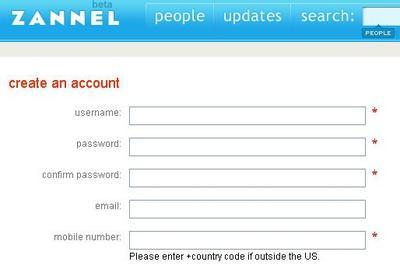Here’s the image, and the asterisk, that inspired today’s column, originally in MediaPost. You can see my profile on Zannel here.
One Small Asterisk, One Leap For Digital Media
Here’s one of those moments when you realize how quickly media is
changing: when registering with a content-sharing community, an email
address is optional, but a mobile phone number is required.
That’s what I found when signing up for Zannel.
Not long ago, such sites wouldn’t even ask for your mobile number, but
now it’s all they need. All that changed here was the position of an
asterisk, but it signified something much bigger. Mobile phones, which
a couple years ago seemed ill-suited for anything but talking (and many
couldn’t do that particularly well), are becoming the default content
production and distribution devices for millions of consumers.
Mobile phones still have a number of disadvantages. Connection
speeds are slow with the mobile Web. Unlimited data plans are often
prohibitively expensive. The resolution of multimedia captured on a
$500 phone will be much lower quality than what’s taken with a $200
camera (Exhibit A: my grainy blog post from Digital Hollywood
this month, captured from my Samsung i760). Phones currently have few
ways to edit photos; if you’re not using an iPhone, even rotating a
picture 90 degrees can be burdensome. More sophisticated edits, like
all the photo fixes Google’s Picasa provides in a single click of its
“I’m feeling lucky” button in its downloadable PC software, are rarely
available.
None of those hurdles are insurmountable. Do you remember the first
time you took or viewed a digital photo? I do. My dad got a Sony Mavica
in the late 1990s that stored photos on 3.5″ disks. Instead of taking
pictures of the house or the family, I took a series of photos of
schwag my dad got from a gastroenterology conference, which I turned
into one of my first PowerPoint presentations, “The Adventures of
EneMan” (he still shares it with his fellows). The photos were barely a
fraction of the quality of print photos, and it will take you less time
to read this column than the wait between shots on the Mavica, but
those inferior products had infinite possibilities. It took a few more
years before I gave up on film altogether — I think my last sets of
negatives are from 9/11 and a trip two months later to San Francisco —
but the death of film was imminent.
Mobile media is undergoing a similar transition. Why are early
adopters sacrificing quality and using Zannel, along with related
services like Kyte and Qik and mobile extensions of Flickr, WordPress, TypePad, and Facebook’s photo sharing? Here are four reasons:
Immediacy: Some of these services can stream live
video from the phone. A photo can go up on a blog within seconds of
snapping it. Friends following you on Zannel can see your photos
instantly on their own phones. See something — or even think of it —
and you can share it instantly. That’s not always a plus, as more
poor-quality content gets produced. By the same reasoning, however, the
printing press allowed more awful books to come out, yet I’d wager few
readers would want to turn the clock back to the pre-press days of
1438.
Efficiency: With mobile media-sharing, there’s no
shifting memory cards around, looking for cables, or switching devices
(though one can record multimedia on other devices like digital cameras
and Flip video cameras and share them later). One pocket-sized,
Web-enabled device can record and share text, speech, music, images,
and video.
Portability: “Always on” used to refer to broadband
access, but now it’s even more applicable for devices that are always
on you and always online. When’s the last time your phone was out of
arm’s reach?
Access: It’s a matter of time before just about all
phones have some degree of mobile Web access. That’s not even required,
though. Zannel, for instance, works perfectly well with a camera phone
and MMS (multimedia messaging service).
All four of these factors have at least surpassed the “good enough”
threshold, and the technology is often staying ahead of what consumers
want to do with it. If you want to create any kind of content on your
phone and share it with any site or group of contacts, there’s a way to
do it, and the features get richer by the day.
One can rightfully
grow skeptical of the hype of convergence. For years, people have owned
camera phones but only shared pictures taken on digital cameras. Now,
the camera phones benefit from higher MMS and mobile Web penetration
and new applications that tie it all together.
And to think, all of that’s summed up in one slight shift of an asterisk.








People reacted to this story.
Show comments Hide commentsDavid – great column. I think that one of the most overlooked aspects of the entire mobile craze is the data plan (which I feel has yet to reached top market potential yet … but thats another topic for another day). An unlimited data plan is a must in order to utilize these services and the further proliferation of the mobile web will be built upon the data first, content second.